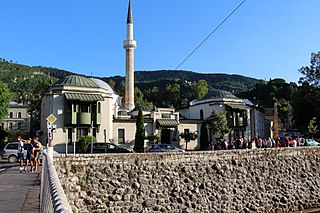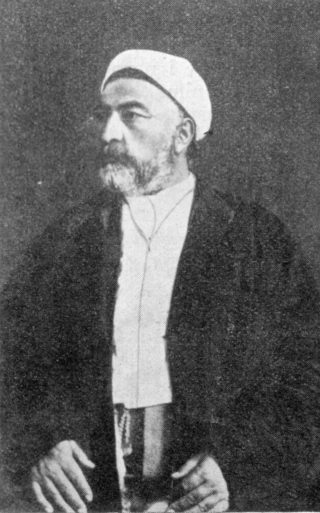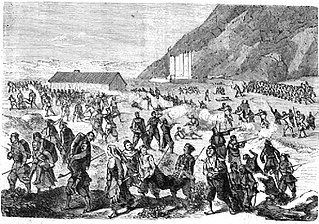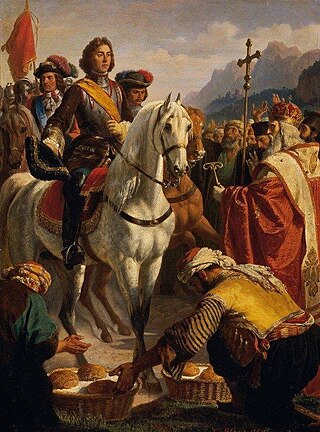Sarajevo is a city now in Bosnia and Herzegovina.

Stari Grad is a municipality of the city of Sarajevo, Bosnia and Herzegovina. It is the oldest and most historically significant part of Sarajevo. At its heart is the Baščaršija, the old town market sector where the city was founded by Ottoman general Isa-Beg Ishaković in the 15th century.

Gazi Husrev-beg Mosque is a mosque in the city of Sarajevo, Bosnia and Herzegovina. Built in the 16th century, it is the largest historical mosque in Bosnia and Herzegovina and one of the most representative Ottoman structures in the Balkans. Being the central Sarajevo's mosque since the days of its construction, today it also serves as the main congregational mosque of the Muslims in Bosnia and Herzegovina. It is located in the Baščaršija neighborhood in the Stari Grad municipality and, being one of the main architectural monuments in the town, is regularly visited by tourists.

The Emperor's Mosque is an important landmark in Sarajevo, Bosnia and Herzegovina, being the first mosque to be built (1457) after the Ottoman conquest of Bosnia. It is the largest single-subdome mosque in Bosnia and Herzegovina, built in the classical Ottoman style of the era.

The Austro-Hungarian Army was the land force of the Austro-Hungarian Dual Monarchy from 1867 to 1918. It was composed of three parts: the joint army, the Imperial Austrian Landwehr, and the Royal Hungarian Honvéd.

SMS Viribus Unitis was an Austro-Hungarian dreadnought battleship, the first of the Tegetthoff class. "Viribus Unitis", meaning "With United Forces", was the personal motto of Emperor Franz Joseph I.

Husein Gradaščević (Husein-kapetan) was a Bosnian military commander who later led a rebellion against the Ottoman government, seeking autonomy for Bosnia. Born into a Bosnian noble family, Gradaščević became the captain of Gradačac in the early 1820s, succeeding his relatives at the position. He grew up surrounded by a political climate of turmoil in the western reaches of the Ottoman Empire. With the Russo-Turkish war (1828–29), Gradaščević's importance rose; the Bosnian governor gave him the task of mobilizing an army between the Drina and Vrbas.
The architecture of Bosnia and Herzegovina is largely influenced by four major periods, when political and social changes determined the creation of distinct cultural and architectural habits of the region.

Doboj Fortress or Gradina (Градина) is located in the city of Doboj, Bosnia and Herzegovina. Throughout its turbulent history, the fortress has been burned and ransacked at least 18 times as per official records. Of note is that Doboj fortress was considered to be a royal Kotromanić property, unlike Great Bosnian Duke Hrvoje's Zvečaj fortress or Sandalj Hranić's Blagaj fortress, which were centers of their respective duchies.

Bosnia and Herzegovina fell under Austro-Hungarian rule in 1878, when the Congress of Berlin approved the occupation of the Bosnia Vilayet, which officially remained part of the Ottoman Empire. Three decades later, in 1908, Austria-Hungary provoked the Bosnian Crisis by formally annexing the occupied zone, establishing the Condominium of Bosnia and Herzegovina under the joint control of Austria and Hungary.
The Battle of Banja Luka took place in Banja Luka, Ottoman Bosnia, on 4 August 1737, during the Austro-Russian-Turkish War. An Austrian army under Prince Joseph Hildberghausen was defeated, as it attempted to besiege the town, when it ran into a large Ottoman relief force led by Bosnian Vizier Hekimoğlu Ali Pasha.

Josip Filipović, Freiherr (Baron) von Philippsberg, also Josef von Philippovich or Joseph Philippovich, was an Austro-Hungarian general (Feldzeugmeister).

Centuries before the Ottoman conquest of Bosnia, Mostar was a small hamlet situated at a strategic crossing of the Neretva river. Its hinterlands consisted of a broad agricultural plain on the west bank and steep terraces on the east bank surrounded by barren mountains. Mostar was a representative multi-ethnic and multi-cultural settlement in Bosnia and Herzegovina, which had possessed an independent political identity since the twelfth century. By the fifteenth century, most of the lands that would later become part of modern Yugoslavia were inhabited primarily by peoples of the same south Slavic heritage.

The anti-Serb riots in Sarajevo consisted of large-scale anti-Serb violence in Sarajevo on 28 and 29 June 1914 after the assassination of Archduke Franz Ferdinand. Encouraged by the Austro-Hungarian government, the violent demonstrations assumed the characteristics of a pogrom, which led to ethnic divisions that were unprecedented in the city's history. Two Serbs were killed on the first day of the demonstrations, and many others were attacked. Numerous houses, shops and institutions owned by Serbs were razed or pillaged.

Mustafa-beg Fadilpašić was the first Mayor of Sarajevo, Bosnia and Herzegovina. He was appointed mayor in 1878 after more than 14,000 Austro-Hungarian troops, led by Josip Filipović, captured Bosnia and Herzegovina from the declining Ottoman Empire. He remained the mayor for the last 14 years of his life.

The campaign to establish Austro-Hungarian rule in Bosnia and Herzegovina lasted from 29 July to 20 October 1878 against the local resistance fighters supported by the Ottoman Empire. The Austro-Hungarian Army entered the country in two large movements: one from the north into Bosnia, and another from the south into Herzegovina. A series of battles in August culminated in the fall of Sarajevo on the 19th after a day of street-to-street fighting. In the hilly countryside a guerrilla campaign continued until the last rebel stronghold fell after their leader was captured.
Riyasat is a main executive body of the Islamic communities in the Balkan region. The head of the riyasat is Reis-ul-ulema.

The Krivošije uprising of 1869 was an internal conflict in the far south of the Austro-Hungarian Empire that broke out following the Austro-Hungarian government's decision to extend military conscription to the Serb tribe and region of Krivošije. It lasted from October 1869 until a formal peace accord was signed on 11 January 1870. The rebels managed to defeat the Austro-Hungarian army detachments sent against them and in the end the government conceded on all points of dispute.

SMS Tegetthoff was the second of four Tegetthoff-class dreadnought battleships built for the Austro-Hungarian Navy. Tegetthoff was named for the 19th-century Austrian Admiral Wilhelm von Tegetthoff, most notable for defeating the Italian Regia Marina at the Battle of Lissa in 1866. The ship was armed with a main battery of twelve 30.5 cm (12.0 in) guns in four triple turrets. Constructed shortly before World War I, she was built at the Stabilimento Tecnico Triestino shipyard in Trieste, where she was laid down in September 1910 and launched in March 1912.

The sacking of Sarajevo took place on 23 October 1697 and was committed by raiding Austrian troops led by Prince Eugene of Savoy. At this time the Great Turkish War was being fought. Shortly after the Austrian victory at the Battle of Zenta, an opportunity arose for the Austrians to launch a surprise attack into Ottoman Bosnia.




















